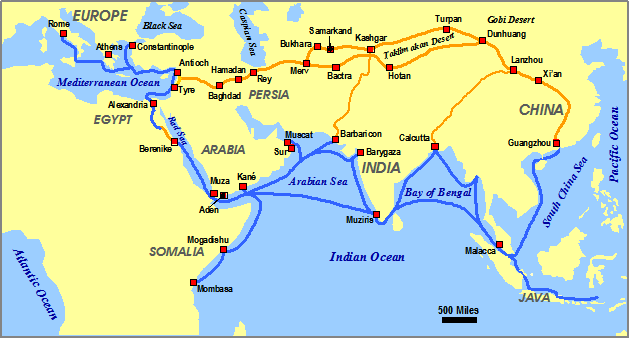If we go back to the second and third centuries C.E. and to the trade routes of the Silk Roads, we find the Chinese Han Dynasty and the Roman Empire suffering large-scale outbreaks of epidemic disease.1 The most destructive of these diseases were probably smallpox and measles, and epidemics of bubonic plague may also have erupted.2 Although these diseases are the most well-known, there were many others. We have long suspected that disease traveled via the Silk Roads; and now we have the proof. Piers Mitchell, a paleopathologist at the University of Cambridge states, “This is the earliest evidence for the spread of infectious diseases along the Silk Road, and the first to find evidence at an archaeological site along the Silk Road itself.”3 Without the technology and medicinal techniques we practice today, the fatalities that these populations suffered were devastating.

The silk roads were an extensive series of trade routes that linked much of Eurasia and north Africa.4 The Xuanquanzhi relay station was a well known area along the Silk Roads that housed travelers and relayed messages. It was located in the town of Dunhuang, a key stopping point on the Silk Road within the Hexi Corridor.5 Not only were necessities exchanged here, but so were religions, cultures, and the many diseases. Through a study in China conducted by Doctors Hui-Yuan Yeh, Ruillin Mao, Hui Wang, Wuyun Qi, and Piers D. Mitchell, they were able to prove that Chinese liver fluke, roundworm, whipworm, and tapeworm were spread along the Silk Roads.6
The study took place in Gansu Province, located in north-west China, which contains the Hexi Corridor.7 This corridor formed a section of the Silk Road, an ancient network of thoroughfares extending 4000 miles.8

Hygiene sticks were excavated from the latrines at the Xuanquanzhi site in 1992. These sticks were made of wood or bamboo wrapped with cloth, to be used as personal hygiene sticks for wiping.9 Out of the many sticks that were collected, seven of them had remnants of fecal matter still attached. The samples were then mixed with distilled water and trisodium phosphate in order for the parasites to be isolated. The most significant finding was the Chinese liver fluke, as it could not have been endemic at Dunhuang, as the parasite requires a wet marshy environment for its life cycle.10 Due to the discovery of this specific parasite, it proves the argument that the Silk Roads were partly to blame for the mass distribution of diverse diseases. Although there are various ways for diseases to be distributed all over the world, travelers along the Silk Roads provided an easy way for some of the most deadly diseases to travel great distances to devastate two of the largest empires of the ancient world: the Chinese Han Dynasty and the Roman Empire.
- Jerry H. Bentley, Herbert F. Ziegler, and Heather E. Streets-Salter, Traditions & Encounters: A Brief Global History: Volume 1: To 1500, Fourth Edition, vol. 1 (New York, New York: McGraw-Hill Education, 2014), 166. ↵
- Bentley, Ziegler, and Streets-Salter, Traditions & Encounters: A Brief Global History, 166. ↵
- Charles Q. Choi, “Silk Road Gave Infectious Disease a Route, Ancient Poop Shows,” Live Science, July 21, 2016, accessed October 25, 2016, http://www.livescience.com/55505-silk-road-human-feces-infectious-disease.html. ↵
- Bentley, Ziegler, and Streets-Salter, Traditions & Encounters: A Brief Global History, 161. ↵
- Hui-Yuan Yeh et al., “Early Evidence for Travel with Infectious Diseases along the Silk Road: Intestinal Parasites from 2000 Year-Old Personal Hygiene Sticks in a Latrine at Xuanquanzhi Relay Station in China,” Journal of Archaeological Science: Reports 9 (October 2016): 759. ↵
- Hui-Yuan Yeh et al., “Early Evidence for Travel with Infectious Diseases along the Silk Road: Intestinal Parasites from 2000 Year-Old Personal Hygiene Sticks in a Latrine at Xuanquanzhi Relay Station in China,” Journal of Archaeological Science: Reports 9 (October 2016): 758. ↵
- Hui-Yuan Yeh et al., “Early Evidence for Travel with Infectious Diseases along the Silk Road: Intestinal Parasites from 2000 Year-Old Personal Hygiene Sticks in a Latrine at Xuanquanzhi Relay Station in China,” Journal of Archaeological Science: Reports 9 (October 2016): 759. ↵
- Hui-Yuan Yeh et al., “Early Evidence for Travel with Infectious Diseases along the Silk Road: Intestinal Parasites from 2000 Year-Old Personal Hygiene Sticks in a Latrine at Xuanquanzhi Relay Station in China,” Journal of Archaeological Science: Reports 9 (October 2016): 759. ↵
- Hui-Yuan Yeh et al., “Early Evidence for Travel with Infectious Diseases along the Silk Road: Intestinal Parasites from 2000 Year-Old Personal Hygiene Sticks in a Latrine at Xuanquanzhi Relay Station in China,” Journal of Archaeological Science: Reports 9 (October 2016): 759. ↵
- Hui-Yuan Yeh et al., “Early Evidence for Travel with Infectious Diseases along the Silk Road: Intestinal Parasites from 2000 Year-Old Personal Hygiene Sticks in a Latrine at Xuanquanzhi Relay Station in China,” Journal of Archaeological Science: Reports 9 (October 2016): 761. ↵



34 comments
Nahim Rancharan
This article was a very interesting read especially since in new little about the SilK Trade Road or their affect on the spread of Disease in the Chinese Han Dynasty and the Roman Empire. It was fascinating to see how easy it was to spread common diseases today, more specifically in times where there were advanced forms of healthcare and effective medical practices. Funny enough, although these roads were affective in enhancing trade and the spread of culture and ideas, it was also effective at, unfortunately, spreading diseases most of which killed thousands during that time. It was also good to see how the article was supported by archaeological research helping to trace back the patterns of the spread of the diseases as well as the finding of tools that were used for hygienic purposes to remedy this issue in those times. Great Job!
Marissa Gonzalez
It is unfortunate how the Silk Roads spread disease when its main purpose was to transport and trade goods and other resources. I found it amazing, yet a little grossed out about how the disease could still be found on the hygiene sticks. I feel that the remnants of items, not necessarily of these kind mentioned in this article, are able to give us more evidence about history. However, the spread of the disease impacted the people who were associated directly with the Silk Road. Then it is like a chain reaction where those people affected, affect others if they are selling or trading more resources. This was a well informative article. I learned something new about the Silk Roads that I was not familiar with before.
Mario Sosa
Although I have heard of the silk roads before, I did not realize how extensive they were. When you have an enormous trade route that stretches from Rome to eastern China, it is not surprising that many diseases have been spread. The ability to trade supplies, culture and religion unfortunately did have its disadvantage with the exchange of foreign diseases. Interesting read, good job!
Nicolas McKay
Its amazing to think that evidence of fecal matter and whatever parasites lived inside could still be found to this day. This and the story it tells really goes to show you just how much history can be found all around us. Its so interesting to think how much countries depended on the trade brought by the silk road, yet all of the diseases that come from it as well. If they knew that the Silk Road was the casue of many of their illness, I wonder if the people back then would still use it as much as they did. Fantastic article through and through
Daniel Bailey
Its pretty impressive to learn about the outcomes that the silk roads had in ancient time especially with the start of the first pandemics by bringing different exotic infections from across the continent. Funny to think that one of the ways they where able to prove that the silk roads where used was by testing petrified remains of human waste. I found this article quite interesting and I was able to learn extensible about the silk roads and the cities that popped up as a way to make money from the travelers.
Mario De Leon
The Silk Road is very impressive because it was a way to connect the world. Something that I never thought about was the disease that the Silk Road carried or how easy it made for disease to travel a great distance. I thought the way they found the parasites on the hygiene sticks was bizarre and gross but it helped us make an interesting discovery about the silk road.
Yesenia Cardenas
The Silk Roads were so important for people to give information and goods. I enjoyed that you also added how the routes also brought diseases.
Rafael Ortiz Salas
I never had an idea that diseases spread out through the silk road. At the same time it makes sense, because they used it for transportation and trading, and the people that traveled through the silk road got infected from it. Thankfully, our modern science has discover many ways to cure most of the diseases. Very Interesting article. 🙂
Tina Valdez
The Silk Road, I would think, is one of the most commonly learned about trade routes in history. I would imagine this evidence can lead scientists to open more doors as to how these diseases have been spread. Your article made me wonder about the diseases that were spread on the Silk Road; I know very little about tapeworm and the other disease mentioned in your article. I thoroughly enjoyed reading your article, good work!
Andres Palacios
Very interesting the way trade routes affected and were what cause diseases such as measles, small pox, and the black plague to spread out to the rest of the world. When I was younger I always wondered how could a disease such as the black plague start in one place and spread out to the rest of the world, trade routes such as the Silk Roads were the cause of the spreading of most diseases that affected so many through the years. Very well written and informative article.